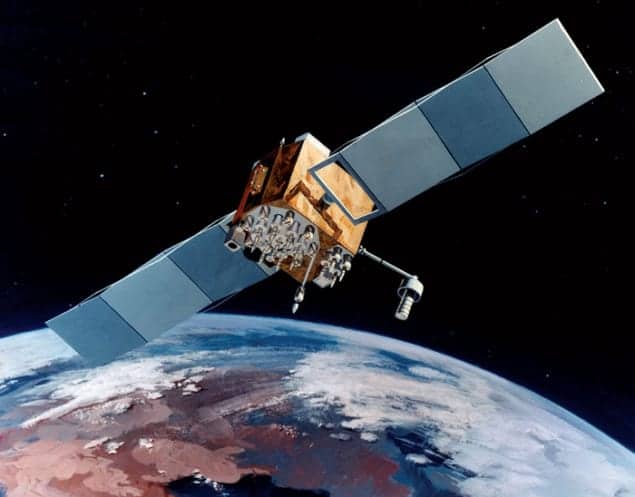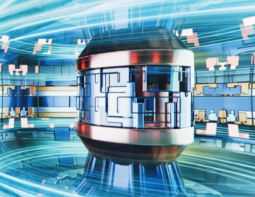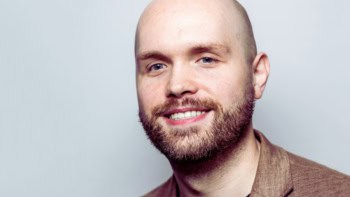
Plans for a global network of atomic clocks that are synchronized using quantum entanglement have been unveiled by physicists in the US. The resulting universal time standard would be more accurate than is currently possible with individual atomic clocks, and the network could also be used to do a range of fundamental and applied research, such as mapping the Earth’s gravitational field or even testing new theories of gravity. While some of the technologies needed to build the network already exist, other elements still need further development.
Atomic clocks have revolutionized the world in ways that were unimaginable when the first atomic clock was built in 1949. The Global Positioning System (GPS), for example, uses atomic clocks to measure the travel time of signals from four satellites to a GPS receiver almost anywhere on Earth. As clocks have become more accurate, researchers have proposed ever-more-exotic applications such as relativistic geodesy, in which the strength of gravity at various points, and therefore the local density of the Earth, could be mapped by measuring variations in the rates of clocks at different locations. Scientists have also suggested that ultra-accurate atomic clocks placed in outer space could detect gravitational waves.
The ultimate limits on the stability of a single atomic clock are determined by Heisenberg’s uncertainty principle, which limits how precisely a system’s oscillations can be measured. This has been drastically reduced in recent years with the invention of optical lattice clocks containing thousands of particles, allowing the quantum uncertainty to be reduced by averaging. In the new research, Mikhail Lukin’s quantum-optics group at Harvard University has teamed up with Jun Ye’s quantum-metrology group at the National Institute for Standards and Technology (NIST), the JILA Lab and the University of Colorado. Ye’s team holds the current world record for clock accuracy, and now the two groups have come up with a way to make an even better timekeeper by effectively combining several atomic clocks into one.
Entangled super clock
Their plan involves many clocks, all stationed in different countries and connected by both classical and quantum links. In each cycle of the synchronization process, one clock (the “central clock”) sends out one photon from an entangled pair to each of the other clocks, via the quantum link. This allows the clocks to prepare a single, collective entangled state and to transfer this entangled state on to the atoms in the clocks. Each clock then measures this collective entangled state and, after doing so, it uses the classical link to send both its own laser frequency and the phase difference it measures between this laser frequency and the atoms to the central clock. The central clock can then calculate the average phase difference and use it to calculate the correction that needs to be applied to the frequency to bring all the clocks back into phase. The clocks thereby reduce their uncertainty by collectively averaging over all the atoms in all the clocks, effectively behaving as a single, super-accurate atomic clock.
This distributed set-up would provide all the participating parties with access to the ultra-precise time signal at any time, creating a universal time standard. The network would also be more secure against physical attack because, even if one of the systems were disabled, each party could fall back on its own atomic clock. Finally, it might be possible to use changes in the rate of individual clocks to detect gravitational waves or even to test new theories of gravity. “If you have this very good reference, and there is a local node that doesn’t follow this reference, then that’s a signal,” explains Lukin. It could either mean that the clock is not working properly, he says, or it might represent something more fundamental. In principle, one of the clocks could be taken out of the Earth’s gravitational field to make non-local tests of fundamental physics, for example, although the engineering challenges would be severe.
Far-fetched but well-reasoned
Eugene Polzik, a quantum-optics expert whose team at the Niels Bohr Institute in Copenhagen built the first atomic clock containing entangled atoms, describes the proposal as “very interesting and important”. He says, however, that before the scheme can be realized, two main technical hurdles must be overcome. First, scientists must successfully generate the giant quantum state containing far more atoms than has so far been achieved, and second, quantum repeaters will have to be developed to allow entanglement distribution around the world. “We have to dream,” he concludes. “And it’s always good to have a far-fetched proposal, which is backed up by reason, and that’s exactly what this paper is doing.”
The proposal is described in Nature Physics.
Read more about Polzik’s entangled clock in “Entanglement-assisted atomic clock beyond the projection noise limit”.



